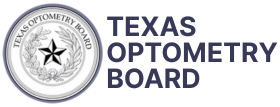The Texas Optometry Board wants you to know how to tell if you are obtaining an appropriate eye examination from your optometrist. Whenever you see an optometrist for a glasses or contact lens prescription for the very first time, Texas law requires the optometrist to perform several tests before he or she can write a prescription for you.
The reason the law requires these tests is to make sure that you can have a minimum level of assurance that your vision and the health of your eyes is good. These tests are important and represent the minimum of testing you should have done as a new patient when seeing an optometrist.
- Case History – The doctor should find out about your medical history. You should be asked about any family history of eye problems. Also, you should be able to share any unusual requirements that your work or hobbies require of your eyes and vision. All of these are important because the answers can guide the doctor to make better decisions about how to best help you.
- Visual Acuity – The doctor or technician should have you read letters on a chart with each eye individually and together. This may be done with you reading a chart far away from you and another one close to you, like reading from a book. Sometimes people may not realize one eye may be seeing much better than the other. The result of this test lets you find out if you have 20/20 vision or not.
- Biomicroscopy – The doctor should examine the front of your eyes with a special microscope and light. This allows the doctor to closely examine the area around your eyes, as well as the surface and deeper areas of the eye. Usually this requires you to place your chin on a chinrest and lean forward. The doctor will then use a moveable light as they look through a microscope at your eyes. This helps the doctor see anything unusual on the front surface of the eye and surrounding tissues. Texas Optometry Board rules require the doctor to physically perform this test themselves.
- Internal Examination – The doctor must use an instrument to look into the deeper areas of the eye. This may be done by the doctor using a strong magnifying lens with the biomicoscope (see above) or with an apparatus that he or she would hold up to his or her own eye as he or she shine a light into yours. By using these tools, the doctor can see the deeper areas of your eye that include the optic nerve and retina in the back of the eye. There are also many blood vessels that need to be evaluated in this area of the eye. These findings are critical to help ensure continued good vision or to keep you from losing vision. Also, they may alert the doctor to other health problems that may need attention. Texas Optometry Board rules require the doctor to physically perform this test themselves.
- Retinoscopy – The doctor can have a technician use an instrument to find out what your new glasses prescription may need to be. Also, the doctor may use a different instrument to find out this information themselves using lenses and a special handheld light. Knowing this information gives the doctor a way to know what your prescription may be without having to rely on you for answers. This is especially important for people who may not be able to communicate well, like children or other people for whom communication is challenging.
- Subjective Findings – This part of the exam is when the doctor asks you how you see through different lenses. You should expect them to ask you for each eye individually and together. These findings should also be done for closer reading and for reading a chart from across the room. While a technician may do a portion of this, Texas Optometry Board rules also require the doctor to physically perform this test themselves.
- Binocular Function – Your doctor or their staff should test your eyes to know how well they work together. Sometimes our eyes may not perfectly line up with each other when we look at something due to a muscle imbalance. This can cause us problems reading, paying attention, and may cause headaches. If it is especially problematic, it may cause us to see double or force us to close one eye in order to see better.
- Amplitude of Accommodation – The doctor or staff member should test your ability to change focus from far away to something near to you. Sometimes this is done with lenses or it may be done by asking you to pull reading material closer to you until it becomes blurry. Knowing this information will help your doctor find out if you need extra help to read more easily.
- Tonometry – This is a measure of the pressure inside of the eye. Glaucoma is just one of the diseases that affects the pressure inside of the eye. If the pressure is not normal, you could be at risk of losing vision over time. This may be done with what is commonly called the “air-puff” machine or by other methods.
- Angle of Vision – This allows the doctor to know how far to each side you can see. This is important for helping us walk and drive our cars more safely. Because the eye is part of the brain, measuring your peripheral vision is an important part of your eye examination. This test may uncover issues with your eyes even though you may have the ability to read 20/20.
As you can tell, a proper eye exam goes beyond just being asked if it is better through number 1 or number 2! The Texas Optometry Board is here to help make sure that all Texas Optometrists are providing appropriate care to the citizens of this great state.
